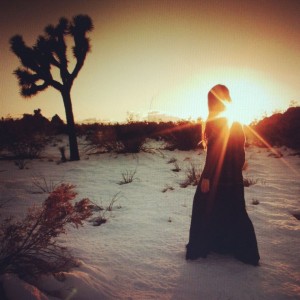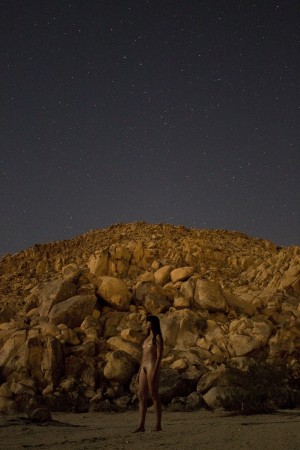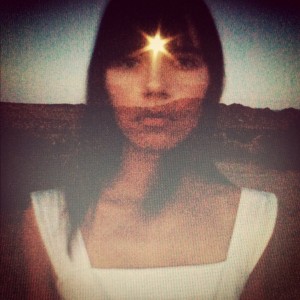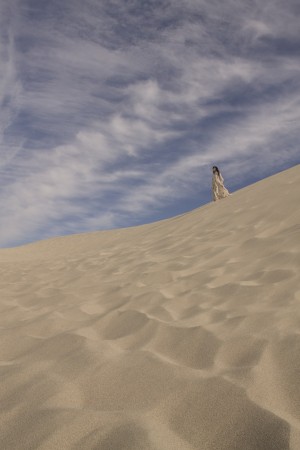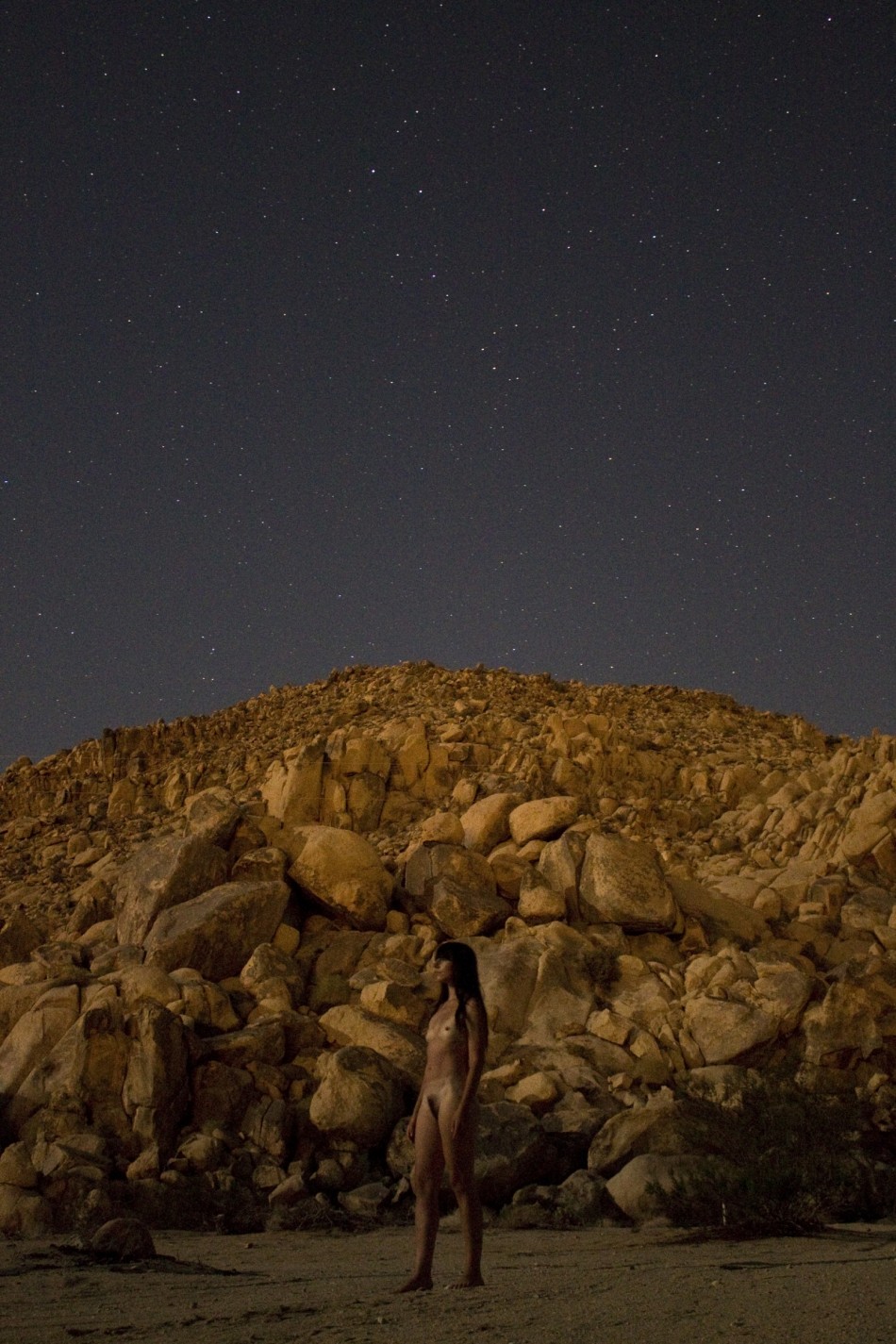
Angela de la Agua, Untitled (Boulders in Moonlight)
Led by the Desert with Angela de la Agua
Coinciding this year with High Desert Test Sites’ week-long art event, HDTS 2013, was artist Angela de la Agua’s This Desert, That Desert, a roving self-portrait photography project that followed the High Desert Test Sites event route. De la Agua lives in Joshua Tree, CA, where HDTS is also based, and she has established her reputation on Tumblr where she publishes daily self-portraits that she shoots in the desert outside Joshua Tree.
The HDTS event began on October 12 in Joshua Tree and traversed 700 miles before ending in Albuquerque on October 19. De la Agua planned her self-portraiture stops to coincide with more than 60 planned artist sites along the HDTS route. The event was billed as showing the artist, “slowly [losing] pieces of clothing, until she arrives in Albuquerque naked.”
De la Agua’s self portraits don’t fit the “#selfies” described by Alicia Eler in “Self Portrait is a lost Art,” in which the writer describes the proliferation of selfies as “decontextualized, awash in a sea of internet anonymity.” De la Agua’s images are more reminiscent of Ana Mendieta’s corporeal nature works of the 1970s, but without the feminist component. While Mendieta’s work references violence committed against women and draws connections to the desecration of the earth, de la Agua is the protagonist in a personal desert drama. Do her private rituals transcend the cultural fixation with self-documentation and extend into meaningful commentary?
Did you make the journey from Joshua Tree to Albuquerque alone?
I drove myself, but it was a caravan and there was a lot of convening with other people along the way at various sites and events.
Is your background in photography?
Actually, I got my art degree in drawing and painting but I became detached from creating work in that medium while I was getting that degree. I was moving myself away from creating an object and putting it on a wall. My teachers encouraged me to do whatever I wanted, basically, because there was no program for conceptual art or installation.
Were you interjecting yourself in the work then, like you’re doing now?
A little bit . . . but I wasn’t really working full-on with self-portraiture and the camera until the past three years or so.
Our background determines the lens with which we interpret an artist’s work. For me, your work is very performative.
What I am doing, I have never really considered photography. The self-portraits have always felt like performance. I felt drawn to document my connection with nature. It began at a point in my life where I realized I didn’t have that connection to nature. Four years ago, when I started taking self-portraits, I was searching for nature. That is what I am doing in the pictures: looking for nature. I happened to get a camera around the same time, so those two things immediately connected with each other.
So you document solely by yourself? No one else is working with you?
I work with a tripod and it is all me. It has been very private for a very long time. It has felt performative, but it’s been private.
Tell me about the project you just completed, This Desert, That Desert.
I felt really, really called to do something like this because I have not participated in a normal art world event in a very long time. I felt it was the right time for me. I knew this was going to be good and challenging for me.
I pictured myself taking the journey before the [High Desert Test Sites] event, driving and stopping along the way, finding my connections with the land, finding my space on their route. The photographs were going to be made into books and that was [initially] going to be the presentation for the event — books of photographs. [Later] it made so much more sense to actually, physically go on the trip and travel with everybody, creating the work while the event [was] happening. The books will be presented later.
How did you determine where to stop and photograph?
I decided it was a good idea to stop at the other artists’ sites and do my thing. It would also be much more performative — people could actually watch me. That was new for me: inviting an audience to watch.
Will a viewer find your ritual interesting?
The ritual itself is a walking meditation that involves setting up my camera and tripod, so whether a viewer would find it interesting is dependent on whether a viewer finds watching someone meditate interesting. It’s a slow, silent, and subtle ritual. I myself am particularly drawn to and appreciate quiet acts that require focus as a viewer. I prefer the sort of work that might be easily missed unless one is completely tuned into the present moment.
If you are engaging in ritual that is so private and even hermetic, what do you expect of the viewer?
I am immersed in the act of connecting with the land. I am not thinking about an audience. I have done these private photographs for years, and didn’t begin sharing them until about a year and a half ago. I began choosing to share these private experiences because of a desire to connect with others, which was an honest reflection of where I was in my personal life. I’d lived a life of solitude for a long period in the desert, and as I grew out of the need to be alone, I developed a need to communicate my quiet life and sacred acts with the outside world.
My hope in sharing these rituals is that the viewer feels a vibration, a resonance. Perhaps the viewer feels a connection to me and what I’m doing, or perhaps a connection to the land — or better yet, a desire to have that connection to the land.
How is this work different from the self-portraits you’ve published on Tumblr?
They are a project. They are not like the pictures I take every day. There is definitely a beginning, middle and end to this piece documenting the journey.
Did you arrive in Albuquerque naked?
I did take the “naked” photos in Albuquerque, but it wasn’t literally arriving naked.
Did you actually have an audience?
There were two people there. [Laughs] It was weird, but it was fine. I signed up for this.
Is there a boundary between work created as performance art and work created as personal exploration?
No. I struggle with the word “performance” at times. Although my work is performative by nature, it is not performance as in acting for an audience, or taking on another persona. I’m documenting my movements as I connect to nature, and those movements exist whether I have a camera capturing them or not.
You cite Ana Mendieta, Janine Antoni, Janet Cardiff and Francesca Woodman as influences, based on “the way each utilizes their bodies to connect with nature, self-discovery, and time.” What significance does time play in your process?
My work documents my daily connections with the land, the weather, the sky . . . . Looking back at all of my Daily Trail photographs is to look back in time. They are calendars and diaries of my life made from photographs.

